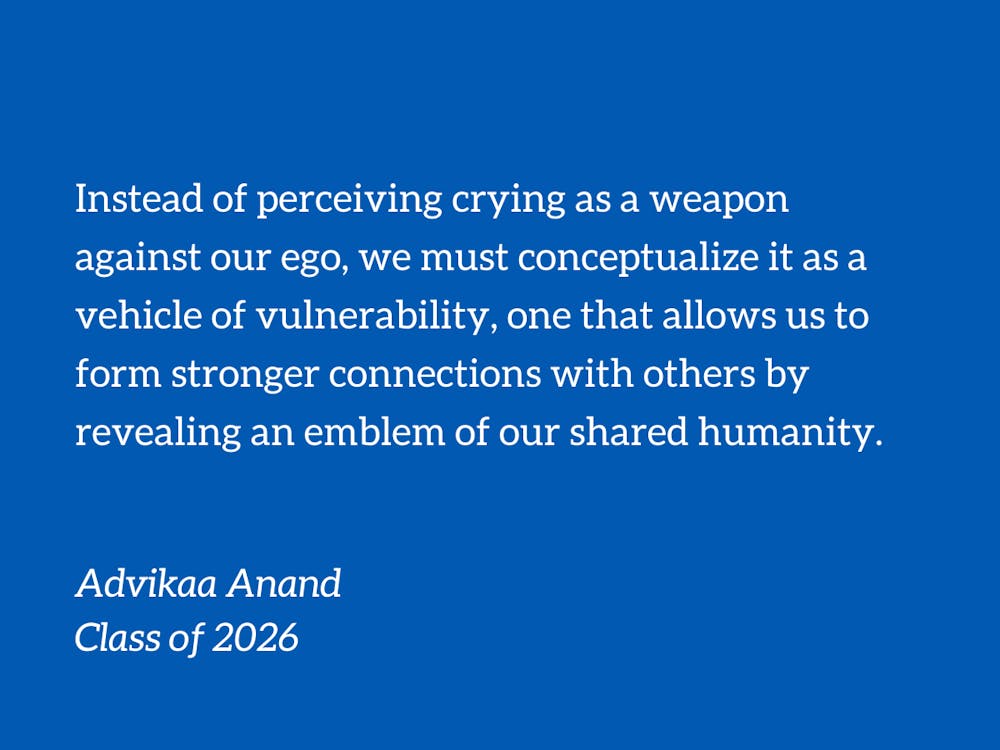As everyone was crafting exciting new year’s resolutions at the beginning of the year, vowing to go to the gym or to learn how to play the piano, I had a different plan in mind: I promised myself that this would be the year that I reduced my crying frequency. I have always been an emotionally expressive person, but crying seemed to induce a crippling weakness that portrayed me as overly histrionical. No longer would I project such a frenzied image to the world.
Needless to say, I failed miserably in abiding by this resolution. I picked the worst year possible to undertake such a mission— I had to contend with the overwhelming burden of college applications and eventually, the stress of a major life transition that is moving to college. In fact, I believe that I have shed more tears in this single year than in the previous five years combined. As I progress through my first semester of college, I am learning to embrace the flow of my emotions, carving time for myself to feel each of them completely. Even as I grasp how to not shirk from my tears, I cannot shake the sentiment that every time I cry, I leak from my most broken fragments, and these cracks provide adversity an opportunity to triumph over me.
My sentiments reflect a greater universal stigma around crying— a crippling mentality that overshadows the intrinsic role this fundamental human expression of emotion plays in our lives. As we work to undo the universal stigma surrounding crying, we must rethink how we conceptualize tears themselves.
We must begin by realizing that tears are not a sign of weakness but instead, an embodied reckoning with our emotions. In fact, crying can be good for you. As Leo Newhouse from Harvard Medical School explains, “medical benefits of crying have been known as far back as the Classical era. Ancient Greco-Roman thinkers posited ‘that tears work like a purgative, draining off and purifying us.’” Today’s prominent psychological findings support this proposition, advocating the premise that “crying releases stress, and therefore is a great practice when it comes to staying mentally healthy.”
Biological evidence substantiates this theory, with several studies showcasing that “emotional tears contain higher levels of stress hormones than do basal (lubricating) or reflex tears (the ones that form when you get something in your eye).” Crying also has benefits necessary to maintaining biochemical homeostasis because “emotional tears also contain more mood-regulating manganese than the other types.” Dr. Stephen Sideroff explains that “stress tightens muscles and heightens tension, so when you cry, you release some of that. Crying activates the parasympathetic nervous system and restores the body’s state of balance.”
And the opposite of the emotional release that crying provides—emotional repression— entails dangerous health consequences: “studies have linked repressive coping with a less reliant immune system, cardiovascular disease, and hypertension as well as mental health conditions, including stress, anxiety, and depression.”
As we analyze the interaction between the health benefits of emotional expression and the pressing consequences of emotional repression, the urgency of undoing the prevailing narrative that links crying with a feeling of shame becomes all the more apparent. This feeling “informs us of an internal state of inadequacy, unworthiness, regret, or disconnection.” Shame may compel us to act in ways that we would otherwise not as we “resort to attacking others to disown what [we] feel.”
Shame reverses the intrinsic health benefits provided by crying.
We must shed this association of tears and shame. Instead of perceiving crying as a weapon against our ego, we must conceptualize it as a vehicle of vulnerability, one that allows us to form stronger connections with others by revealing an emblem of our shared humanity. We must recognize that bottling our tears, while providing fleeting illusions of outward courage, only engenders aggregating weakness over time, flooding our internal systems with toxins and lowering our resolve to contend with life’s challenges.
In the all-too-famous song from Frozen, “Let it Go,” Elsa provides listeners with a contradictory message, proclaiming that she will “let it go” because she “can’t hold it back anymore” while also pledging that “they will never see me cry.” As viewers, we’ll follow the former advice.
Advikaa Anand is a Trinity freshman. Her columns typically run on alternate Thursdays.
Get The Chronicle straight to your inbox
Signup for our weekly newsletter. Cancel at any time.
Advikaa Anand is a Trinity sophomore and an opinion managing editor of The Chronicle's 119th volume.

